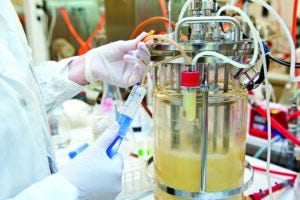Cell Lines Are the Foundation: A Methodical Approach to Derisking Outsourced Development and Improving Manufacturability of Novel BiologicsCell Lines Are the Foundation: A Methodical Approach to Derisking Outsourced Development and Improving Manufacturability of Novel Biologics
April 20, 2023

The most important choice for bringing a novel biologic into clinical development could be the cell line for expressing it. Somewhat determined by that, development of the initial manufacturing process comes in a close second. After an investigational new drug (IND) application, early clinical studies use materials made from the cell line and manufacturing process that were selected at the start of a clinical candidate’s life cycle. The objective for most sponsor companies is to get IND-enabling material produced in the shortest timeline so that clinical trials can begin as soon as possible. Although future process development and optimization can alleviate early concerns related to low-producing clones or low-yield downstream processes, making changes can pose significant risk as a clinical program matures. Risks associated with product comparability (or lack thereof) increase as a biologic moves through the phases of clinical development toward commercialization.
Chemistry, manufacturing, and controls (CMC) professionals would rather not have to perform comparability analysis on a product in late-stage clinical development after a major process change. But developers of novel molecules hesitate to spend their limited resources on such activities before a candidate has been validated clinically. Therefore, process performance qualification (PPQ) and/or process validation (PV) batches and commercial supply readiness for novel biologics often come from low-producing clones and/or low-yielding processes.
The key to success is thus to begin biopharmaceutical development with a cell line that has a good expression titer and a manufacturing process with an acceptable yield and product quality, minimizing the number of CMC changes needed during clinical development. In addition to preventing the dreaded late-stage changes mentioned above, one major benefit of such an approach is that data generated from the cell line and process throughout clinical development can be leveraged in the biologics license application (BLA). Such information could help demonstrate product stability, process operating ranges, impurities clearance, and a molecule’s structural information.
When process optimization must take place during clinical development, it does so under tight timelines and can be fraught with risks to the ongoing clinical supply, thus introducing the potential requirement of clinical comparability testing. If process optimization doesn’t go as desired, then a back-up plan often will be needed to ensure that batches can be manufactured by the old process while a new one is developed and optimized.
Another benefit of establishing a manufacturing process with acceptable titer and yield early in development is increased attractiveness for potential business development initiatives. Many emerging biotechnology companies rely on such initiatives and partnerships for continued financing to advance through clinical trials and meet development goals. During due diligence, potential partners are likely to include thorough assessment of developers’ current manufacturing processes. A low-yielding process is perceived to be unfavorable in partnership discussions because of the process-development challenges that lie ahead to improve yield and overall manufacturing cost of goods sold (CoGS).
Early program decisions for getting IND-enabling material produced in the shortest timeline and with the lowest budget simply delay financial and timeline risk forward to later stages, when they become larger threats to clinical comparability, clinical supply, and licensing-application readiness. However, with proper planning and strategy, many such risks can be mitigated to meet even aggressive timelines and budgets.
Clearly, selection of a cell line and development of an early manufacturing process are critical steps in biologics development. So it is a worthwhile endeavor to make a plan for selecting a cell line and working with a contract manufacturing partner that can achieve the titer and yields necessary for a biomanufacturing process that can be used across all phases of clinical development and even into early commercial supply. Programs are derisked by preventing the need for late-stage process development overhauls or changes in cell line and/or manufacturing process technology.
A Decision-Making Strategy
Over the past 20 years, the industry has made great strides in both cell-line productivity and process yield. When selecting which contract development and manufacturing organization (CDMO) to partner with in development of a novel biologic, sponsors must consider the following key attributes:
• a manufacturer’s experience with cell lines for producing a specific molecule type (e.g., antibodies, Fc fusion proteins, bispecifics, and other therapeutic proteins)
• regulatory acceptability and experience with the chosen cell-line technology, including a strong Module 3 quality data package (1)
• ability to perform robust early process development, optimization, and manufacturability assessment, including evaluation of scalability
• ability to measure key product quality attributes (PQAs) early on
• capability for performing robust formulation development and early stability studies
• financial considerations such as licensing costs, royalties, milestone payments, and cell-line sale terms
• ability to meet timelines.
Cell-Line and Molecule Experience: Many CDMOs will recommend their own proprietary cell-line technologies for manufacturing novel biologics. Others have extensive experience working with third-party cell lines. In either case, it is important to ask the right questions and assess the likelihood that a proposed cell line will be able to produce a candidate molecule successfully for clinical development.
For example, do available data demonstrate that the cell line has produced the specific molecule type successfully? What percentage of a CDMO’s programs are monoclonal antibodies (MAbs) relative to other molecule types (e.g., fusion proteins, bispecifics, and so on)? If a cell line is demonstrably effective in producing one type of biologic, that doesn’t mean it will be just as effective in producing a different type. MAbs constitute a large majority of therapeutic biomolecules produced by today’s modern cell-line technologies; data on other molecule types often can be lacking.
Another concern is whether a cell line can achieve high titers for a given molecule type. When negotiating a cell-line–development proposal with a CDMO, it is a best practice to specify a minimum titer that needs to be achieved from a bioreactor process. That makes the requirements and expectations for cell-line development clear right from the start of a program. Usually, it is desirable to achieve the highest titers possible, but only while maintaining key PQAs.
Development of multiple cell lines in parallel is the ideal path to derisk cell-line selection. Such an approach ensures the ultimate selection of the optimal cell line for manufacturing a given novel biologic. It’s like taking more shots on goal in soccer. This requires an additional investment up front, but it could save millions later in development by preventing the need for a late-stage cell-line switch.
Regulatory Acceptability and Experience: Has a candidate cell line been used for producing clinical materials previously in the country where your IND will be filed? Does the cell line have a strong data package that provides full traceability of its origins and history? The answer should include details on genetic manipulations and whether viral vectors were used to perform such changes. Also, if animal-derived components were used (e.g., fetal bovine serum), did they meet the safety requirements of the country in which your IND will be filed? If your program will be the first time a regulatory agency has seen a given cell-line technology used, then you may face questions about your initial IND submission that could delay its acceptance or even necessitate a clinical hold. You can minimize such delays by addressing the cell line, its history, and testing performed on it during pre-IND interactions with the regulatory agency.
Robust Early Process Development and Optimization: Initial bioreactor studies should evaluate different cell culture media, operating ranges, and feed strategies to maximize product titers while maintaining key PQAs. Microbioreactor technologies such as the Ambr systems from Sartorius make doing so feasible even in early process development. It’s often necessary to perform at least two rounds of Ambr studies, for example, building on information learned in the initial phases. Thus, it’s important to build those into a program’s timeline and budget.
If a CDMO owns the chosen cell-line technology or has previous experience with it, you can leverage that company’s know-how on which basal and feed media work best and which bioreactor operating parameters will be most influential on cell-line productivity. A mid-scale bioreactor study also should be performed to validate the results coming out of those Ambr studies. It also can provide early data on process scalability. Certain physiochemical conditions within a microscale bioreactor might be different from what is found in a mid- or large-scale bioreactor.
Although significant improvements made in upstream processing technologies have raised expression titers overall, advances in downstream technologies have lagged. Separation and purification might require multiple cycles and raw materials that are expensive and difficult to manage. Yields might be disappointing. So initial downstream development studies should be performed to evaluate numerous chromatography resins, viral clearance methods, filters, and buffers. It is useful to establish a minimum step-yield requirement to ensure the highest possible product recovery at each downstream process step. Buffer-screening studies help developers determine in which buffers a product intermediate will be most stable and provide data for maximum allowable hold times between unit operations.
As with bioreactor process development, it is often beneficial to perform at least two rounds of studies so that parameters can be fine-tuned for improved yields and product quality. Early investments in process development will pay dividends later by allowing clinical manufacturing at relatively small scales or minimizing the number of batches that need to be produced.
Manufacturability and Scalability Assessments: Early process development and optimization must include manufacturability assessments. It is important to assess key PQAs such as aggregation and fragmentation of expressed proteins coming out of a bioreactor to determine whether such product-related impurities are too numerous to be cleared by the planned downstream process. Also, product sponsors must develop a plan to study or mitigate factors that arise when processes are scaled up to larger manufacturing equipment: e.g., higher partial CO2 pressure levels in bioreactors, shear effects from agitation, stability concerns with hold times between downstream processing steps, and large-scale chromatography considerations such as resin lifetime. Some cell lines are sensitive to large-scale bioreactor conditions that aren’t present in small-scale bioreactors. Likewise, some resins perform well in small-scale chromatography columns but are extremely difficult to pack and maintain as column diameters increase.
Manufacturability assessment also needs to address the raw materials and consumables that will be used in a given process. Single-supplier and custom raw materials can increase risk as more batches need to be manufactured and such materials become harder to procure. For example, custom cell culture media might be available only through a single supplier — which also raises a potential financial and licensing concern, as discussed below.
Early Measurement of Key PQAs: It is extremely important to establish robust, reliable, and trustworthy product-quality assays before cell-line selection and initial process development. Those assays will be relied upon to inform decision-making during all stages of process development and manufacturing. Analytical development must begin early in a product life cycle. In some cases, it even could make sense to perform prequalification of analytical methods to demonstrate their accuracy, precision, repeatability, and robustness before initiating process development. For biologics, key PQAs often include aggregation, fragmentation, biological activity, glycosylation profile, and peptide mapping results. If a molecule under development has a bispecific structure, then it will be critical to assess for proper molecule orientation. In short, anything associated with the stability or mechanism of action (MoA) of a biomolecule must be evaluated early in cell-line and process development to guard against surprises as the manufacturing process is scaled up.
Robust product-quality assays should be developed as early in development as possible, even as early as when the first transiently expressed protein is produced. It is also important to compare early materials produced by a transiently transfected cell line for in vivo or in vitro proof-of-concept studies with later materials generated using a stable cell line and initial manufacturing process at small scale.
Formulation Development and Stability Studies: Instability of a drug substance and/or drug product can be one of the biggest challenges faced during development of a novel biologic. Tight timelines often necessitate rapid formulation development and provide little time between manufacturing batches for early development and clinical trials. Formulation development thus should take place as early as possible, following a robust study design with a proven track record and using key product-quality measurements that are likely to be stability indicating. To improve your chances for success, select two or three top-performing formulations and begin a stability study with all of them using the first available small-scale development material. Thus, months of stability data will be generated for both normal storage and accelerated conditions until initiation of the first current good manufacturing practice (CGMP) manufacturing run. The final formulation can be selected just before CGMP manufacturing begins. The time gap between initial batches and the first CGMP material production is critical because data from those early studies can be used to inform stability decisions for the material generated using a clinical-scale manufacturing process.
For most novel biologics, an ideal formulation would be one that can withstand both freezing (below –70 °C) and storage at 2–8 °C while providing sufficient product stability. Freezing of a biologic drug substance typically provides for much a longer shelf life. As needed, aliquots of the drug-substance batch can be thawed and filled to supply material for drug-product manufacturing and clinical trials. That strategy could prevent the need to manufacture multiple batches to supply early clinical trials.
Manufacturability assessment must also be performed during formulation development. Selection of excipients needs to include evaluation of how easy they are to procure and whether compendial-grade excipients will be available. If you use novel excipients, you will need to justify those in your IND and defend their quality through appropriate release testing.
Finally, as with cell-line development, formulation development must begin with the end in mind. In this case, that starts with a target product profile (TPP) for the final dosage form. Consider your target patient population and desired route of administration. Will your product be diluted before administration, or will it be delivered undiluted? Will you use a delivery device such as a prefilled syringe? Such considerations will inform initial formulation development. Here too, making changes late in clinical development is risky and will require a comparability analysis just like process and manufacturing changes do.
Financial Considerations: It is important to consider all financial terms associated with your selected cell-line technology. What costs are associated with using a given cell line? Often those begin with up-front payments to access the technology, which are followed by recurring annual payments for the life of a product. Some cell-line technologies require royalties on future sales if an expressed product is approved for marketing. CDMOs that own cell-line technology might offer licensing at no cost if batches are manufactured within their networks. However, if a sponsor chooses to take the product and its process elsewhere — including to owned manufacturing facilities — then royalties and licensing fees often set in and can present high costs to a program.
Sometimes cell culture media or other process raw materials can require licensing as well. If a proprietary growth medium is needed to cultivate cells in a bioreactor, and only your CDMO can procure that medium, then it can be difficult to take the product and process to a different CDMO or bring it in-house for manufacturing in the future.
Meeting Timelines: Although clients must place some trust in a CDMO’s ability to manage its own programs, timeline risks can be mitigated through close collaboration between sponsor and CDMO after some initial due diligence. It is important to assess a company’s track record for delivering on its promises. Will it provide references for other clients developing novel biologics so that they can provide you with some feedback on their experience working with that company? Is the timeline presented at the beginning of the project realistic, and does it factor in potential roadblocks such as failed development studies and material-supply constraints? Although no one wants to plan for failure, it’s wise to include contingency planning in your initial development timeline.
Smart Planning on the Critical Path
You should be able to expect a fast return on capital investment from strategizing early in a program’s life cycle to find a highly productive cell line and establish a robust manufacturing process. Obtaining more product per batch enables companies to manufacture at relatively small scales for initial clinical batches or reduce the number of batches needed to supply clinical trials. For example, a highly productive cell line and high-yielding process could produce all necessary clinical material at the 500-L bioreactor scale rather than the 2,000-L bioreactor scale. That would lower costs significantly simply by using smaller amounts of raw materials such as cell culture media and chromatography resins and fewer consumables such as filters. In times of material supply constraints and high costs, such a strategy could bring significant cost savings (e.g., millions of US dollars). When larger quantities of product are needed to supply late-stage clinical trials or commercial batches, it will be easier to scale up an already robust process than to optimize parameters such as bioreactor titer or downstream-process yields. Doing so poses far fewer risks to comparability than an outright manufacturing-process overhaul would bring.
Often with up-front investments as described above, no major process changes are needed during clinical development. Late-stage process optimization, additional engineering batches, and comparability analyses would not be necessary. Instead, resources could be spent generating additional CGMP batches at scale, and those could be used to supply clinical studies or fill early commercial manufacturing needs. The resulting data could be used to support demonstrating a robust, well-controlled manufacturing process in the ensuing BLA. That could shorten the time to BLA filing, especially when CMC is on the critical path. Early work and investment lead to large time savings in late-stage clinical development.
Smart planning early in the development life cycle of a novel biologic will have long-lasting effects on that molecule’s path to regulatory approval. What might appear to be time- and money-saving choices early on could end up leading to highly negative consequences as a biologic progresses through clinical development. For that reason, a methodical and vigorous approach to cell-line selection and initial process development as outlined herein is key to derisking what is inherently a complex and multifaceted endeavor. Beginning those activities early in novel biologic development will be time and money well spent.
Acknowledgment
I’m grateful to Siddhartha Shrivastava, vice president and head of CMC technical operations at Cue Biopharma ([email protected]) for editing and technical input.
Reference
1 ICH M4Q(R1). The Common Technical Document for the Registration of Pharmaceuticals for Human Use —Quality. US Food and Drug Administration: Rockville, MD, August 2001. CPMP/ICH/2887/99 March 2003; https://database.ich.org/sites/default/files/M4Q_R1_Guideline.pdf.
BPI editorial advisor Jason Condon is director of drug substance technical operations at Cue Biopharma, 40 Guest Street, Boston, MA 02135; 1-617-949-2680; [email protected]; https://www.cuebiopharma.com.
You May Also Like






